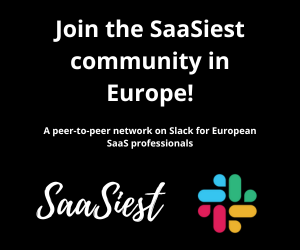
With 17 years of experience across corporate, startup, and scale-up environments, Nieves Canada now leads Settlemint’s CS team, driven by a clear mission: to bring out the best in people. She’s not only passionate about building effective teams but also serves as an executive coach, empowering individuals to reach their full potential.
But here’s where things get interesting: Customer Success has an identity crisis.
Despite its name, customer success often means something different from one company to the next. As Nieves puts it, “We know the name, but pinning down the identity is a different story.” The result? Many CS teams end up with what she calls RALAHC Syndrome – running around like a headless chicken.
Feeling like you’re being pulled in all directions? That’s a sure sign.
In this article, we will walk you through 5 strategic steps to transform your CS organization from chaos to clarity and drive real, measurable impact.
The identity crisis in customer success
“What’s in a name?” Nieves reflects. Our names are identifiers given to us at birth, shaping our identity. But when it comes to customer success, we often know the name, yet struggle to define its true identity.
Over the years, Nieves has observed this identity crisis in CS across different organizations. The role and purpose of CS can vary widely, making it hard for teams to operate effectively. “I’ve seen firsthand how a lack of clarity in the CS function can derail even the most passionate and dedicated professionals.”
The ‘RALAHC syndrome’ and its impact
Nieves vividly describes a scenario from her early CS experience, shadowing a colleague named Sofia. Sofia excelled at understanding the product and educating customers but faced conflicting demands: Sales expected her to drive expansion, while leadership wanted her to prevent churn. The result? Sofia was trying to do everything but achieving nothing. “If this resonates with you, I have a diagnosis: you’re suffering from ‘RALAHC Syndrome’ – running around like a headless chicken,” Nieves jokes, but the underlying issue is serious. This disarray prevents teams from delivering value and hinders business growth.
A common pitfall is hiring without a strategic plan, leading to inefficiencies and unmet goals. Even established CS teams struggle, asking questions like, “How many accounts should each CSM manage?” or “How do we scale effectively?” But the answers are not as simple as setting a revenue-to-headcount ratio.
Avoiding CS missteps and Building effective teams
One of the most damaging mistakes Nieves has seen is setting up CS teams without proper coaching or mentoring. “Sofia wasn’t delivering on expectations because she lacked focus and support,” Nieves explains. Companies often assume that launching a CS department will instantly solve churn problems, but effective CS requires strategic planning and maturity.
Understanding CS maturity levels
It’s important of recognize the four distinct maturity levels within customer success before expecting impactful results. Think of it like assembling a complex puzzle: various roles – product experts, digital CS specialists, onboarding managers, support staff, all need to fit seamlessly into your overall post-sales revenue strategy. But timing is everything. Knowing when to bring in these roles is crucial, as adding them too early or without strategic intent can lead to inefficiencies and missed opportunities.
STAMP: A methodology for success
Nieves has developed the STAMP methodology to bring clarity and direction to Customer Success teams, focusing on five critical components: Stage, Target, Assemble, Manage, and Plan. Here’s a breakdown:
- Stage: Assess your company’s current phase—whether you’re in the startup, growth, expansion, or maturity stage. This assessment is crucial to understand the type of Customer Success team you need. Consider factors like product complexity and customer segmentation. For instance, do you have a straightforward or multifaceted product? Are your clients primarily SMBs, enterprises, or a mix of both? These answers shape the skills and roles required in your team.
- Target: Establish a laser-sharp focus for your team. Without a defined direction, even the most talented CS professionals can lose efficiency. Depending on your company’s stage, you might prioritize:
- “Knowledge ninjas” for customer education and onboarding,
- “Rescue rangers” for churn prevention, or
- “Growth gurus” for expansion opportunities.
Nieves emphasizes the importance of dedicating 80% of your team’s time to a single focus area and aligning KPIs to that goal. “Focus brings results,” she advises, ensuring everyone works cohesively toward a shared objective.
- Assemble: Build your team to suit current needs while planning for future scalability. Nieves advocates for strategic flexibility: “If you can’t hire a digital CS specialist today, leverage resources from Sales or Marketing to manage renewals and develop digital engagement programs.” Regularly evaluate your team’s strengths and passions, placing individuals in roles where they can thrive. This not only boosts performance but also prepares your organization for growth.
- Manage: Empower your team with the right tools, processes, and guidance. Clearly define roles to eliminate ambiguity, segment your customers to prioritize high-ARR accounts, and introduce efficient workflows. Continuous mentoring is a must. “We expect our CSMs to be strategic and confidently engage with CEOs,” says Nieves. “But we have to equip them for those high-stakes conversations.”
- Plan: Stay adaptable. Your strategy must evolve as your business scales from $2 million to $10 million ARR. Nieves recommends revisiting KPIs and processes every 3-6 months to ensure they remain effective. Stay attuned to customer feedback and let it inform your decisions. Being proactive and flexible is key to sustaining long-term success.
A real-world example
Nieves shares how she turned around a CS crisis at one of her customers. With over 3,000 customers and no CS framework, the initial focus was on churn prevention. But after evaluating the business needs, Nieves realized the priority was expansion. By optimizing processes, collaborating with Sales and Product, and introducing key KPIs, her team surpassed their targets.
“We had to do more with less, so we created agile processes,” Nieves says. The success lay in understanding both the business needs and the team’s capabilities. “By empowering my team and tapping into their passions, we transformed challenges into opportunities.”
From chaos to revenue-driven success
The journey from RALAHC Syndrome to a revenue mindset is not easy. “CS should manage revenue in the post-sales journey, whether people like it or not,” Nieves concludes. Her message is clear: with strategic focus, empowerment, and continuous adaptation, CS can drive meaningful impact and business growth.




